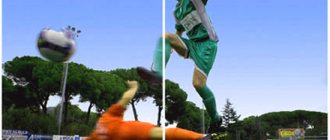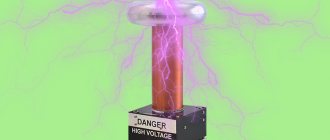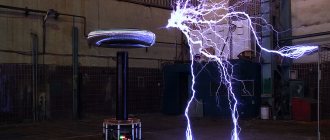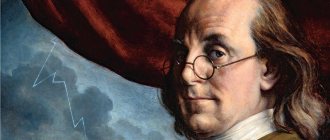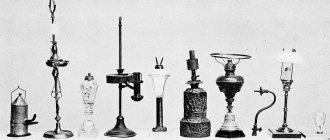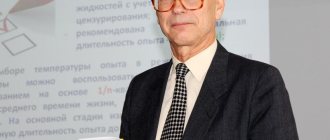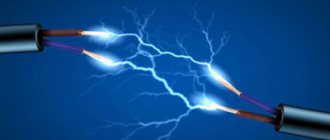Lord of Lightning, Black Mage, Lord of Electricity
Tesla's mythical fame comes from two sources. Firstly, there was a grandiose business battle between the Edison companies (various direct current devices) and Westinghouse (alternating current). We can say that at the turn of the 19th and 20th centuries the modern capitalist market was born, and it was in the USA. All methods of struggle for economic survival were used - right down to physical tricks and performances in front of the public and loud newspaper headlines.
Tesla, apparently, was a very dreamy man, with immense intuition and rich imagination. So rich that, reading excerpts from his numerous press conferences and interviews that he gave to attract new flows of finance, one can imagine Tesla as a kind of semi-mythical character and techno-magician. However, a distinctive feature of almost all of his public appearances is understatement.
Photo: Mary Evans Picture Library/Mary Evans Picture Library/East News
For example, in 1899–1900, a research expedition was carried out in Colorado Springs - this region was famous for constant and frequent thunderstorms. Tesla and his team of engineers studied lightning and built the first experimental installations of enormous size to produce powerful electrical discharges simulating lightning (spark discharge in the atmosphere). It was then that Tesla’s reputation began to take shape among the US population far from science as the “lord of lightning”, “black magician of electricity”, etc. Having developed the design of a large high-frequency emitter , Tesla was actually able to obtain voltages from 12 to 20 million volts (according to various sources) and currents of thousands of amperes. This truly was a design and engineering achievement. Along the way, Tesla confirmed the promising use of several remarkable properties of strong electrostatic fields: fog deposition, cleaning surfaces from rust, dirt, and paint. That is, the million-volt circuits developed by Tesla really opened up new ways to study microwave (high-frequency) currents.
However, upon arrival from Colorado to New York, an extensive article was conceived for Century magazine, devoted to the results of the Colorado experiments. As often comes up when studying the biography of Tesla and his works, there were problems with the article. It looked more like a philosophical treatise or a science fiction novel than a scientific report on new results. But it must be said that many science fiction writers of the early 20th century predicted future technologies in their novels.
The second reason for Tesla's fame and popularity is a fundamental social phenomenon. During the period between the world wars, the United States had already become the most powerful world power. But everyone treated the Americans like yesterday’s colony. This gave rise to a strong inferiority complex. It was especially bad with science. In Europe, science developed over many centuries, even millennia. In terms of engineering work, the Americans did simply miracles in the fruitful conditions of a rapidly developing market, but for scientific success it was necessary to develop their own scientific school, traditions and experience. All this required considerable time, so politicians and strategists sought to get scientists from other countries. This required authority, which they tried to gain as quickly as possible - for this purpose, the (often biased) achievements of their own scientists and engineers were overly promoted. It is no coincidence that many historians of physics note numerous attempts to nominate Tesla and Edison as Nobel laureates, as well as serious pressure on the recognition of Pluto as a planet, because the discovery was made by the American astronomer Percival Lowell.
Death ray
It is known that in the 1930s, Tesla worked on creating a weapon called the “Death Ray,” capable of protecting the borders of any state from enemy invasion and operating on a fundamentally new type of energy. According to Tesla's idea, a beam the size of a hundred millionth of a human hair was supposed to melt aircraft engines at a distance of 400 kilometers.
It is believed that in the mid-1930s the scientist sold his invention to the leadership of the USSR. However, this information has not been confirmed.
First or not? Who cares!
Let's try to evaluate the works of Nikola Tesla as objectively as possible and understand the important role he played in the second world industrial revolution of the early 20th century.
Conventionally, Tesla’s working life can be divided into two periods: before the fire in his laboratory in New York in March 1895 and after.
Before this event, Tesla's inventions can confidently be called extremely effective, useful and ingenious. Many are reliably confirmed by patents and articles. It is very important here to try to imagine the state of the scientific and engineering society of that time. In the 19th century, the discoveries of Oersted, Ampere, Ohm, Faraday, Maxwell and other scientists led many to a clear understanding that electromagnetism was the future. A huge number of brilliant minds around the world have been busy exploring the applications of electrical and magnetic phenomena. If in one country one person achieved some kind of technical discovery, then in another part of the globe at the same time another person could easily construct something similar. Therefore, debates about who was first continue to this day. Although why not just determine that several people were first? Does this detract from their merits?
Photo: East News
This happened many times later with the legacy of Nikola Tesla. For example, it is reliably known that in 1891 he demonstrated in practice the use of radio communications using a transmitting device with a resonance transformer . This is confirmed by the famous radio-controlled model of Tesla's boat. It’s hard to imagine, but back at the end of the 19th century, humanity saw the remote control of a boat model. Of course, there is debate about who came first - Tesla or the Russian physicist Alexander Popov, who created radio around the same time.
“ray tubes” in the 1890s , powered by resonant transformers of his own design and emitting, as they are now called, X-rays. The question of the priority of such an outstanding discovery, for which Wilhelm Roentgen received the Nobel Prize in 1901, is still being discussed. However, Tesla himself did not claim the discovery.
In addition, Tesla, being a proponent of the theory of the existence of an electrical ethereal medium, explored the possibility of creating channels in the ethereal medium through which huge electrical impulses could be transmitted. By all indications, this idea was ahead of its time by almost half a century. Now this phenomenon is called a plasma cord. However, there is no evidence of any clear and substantiated result of Tesla, only about the idea and trial experiments.
The same applies to well-known speculations about knowledge of ball lightning . There are many references at the level of conversations and interviews. According to Tesla himself, he was not interested in this phenomenon, which he understood, since it was a side attribute in the creation of powerful spark discharges, with which Tesla hoped to transmit electricity wirelessly. However, the phenomenon has not been clearly explained either then or now.
October 12, 1887 is an important date in Tesla's career. On this day, he published a rigorous scientific description of the essence of the phenomenon of a rotating magnetic field . This important discovery contributed to the fact that subsequently the unit of measurement of magnetic induction in the international system of units SI was named in honor of Nikola Tesla.
While working for Westinghouse, Tesla patented many different applications for a wide variety of polyphase alternating current systems. Before the invention of the so-called asynchronous motor, alternating current was not widely used, since it could not be used in previously existing electric motors operating on direct current.
Charging for the tail
Wireless power transmission has already been used in some areas. Thus, most electric toothbrushes have long used the inductive bonding method for obvious reasons - any contact with water can lead to a short circuit, and an apartment that burns out due to the fault of a toothbrush is unlikely to add popularity to manufacturers. The design is moderately simple, like everything ingenious: one magnetic coil is placed at the bottom of the brush, and a second one is located in the stand. When the brush is installed in the stand, the magnetic fields of the coils begin to interact and charge the built-in batteries.
| Is Marin Soljachich destined to become the Nikola Tesla of the 21st century? Let's hope he manages to commercialize the WiTricity technology, we're really tired of wires. |
CES 2009
at the beginning of 2009, it was full of solutions based on inductive coupling.
Numerous manufacturers have decided to simplify the process of connecting to chargers - that is, we are gradually moving into the wireless era. An excellent example of a new concept can be considered the developments of the company Powermat
, which presented a whole line of devices for wireless charging of various equipment.
Powermat offers everyone who wants to buy an induction mat and receivers for the most popular devices - a docking station for Apple iPod
, housings for smartphones, plugs for laptops and digital cameras. After connecting the receiver, all that remains is to place the charging device on top of the mat - and that’s it, charging has begun. Of course, you won’t be able to get rid of connecting the Powermats themselves to power outlets, but at least the number of wires will be reduced by three.
Another discovery at CES 2009 was eCoupled
, created by
Fulton Innovation
. Already this year, various working tools (drills, screwdrivers and even flashlights) with contactless docking stations will appear on the market. All this, of course, is good and healthy, but inductive coupling cannot be called an ideal technology for the near future. Yes, users of a wide variety of mobile equipment will get rid of the need to connect a wire to the devices themselves, will be able to put all their players and cameras on one single mat at once and start charging, getting rid of an armful of wires - but heaven on Earth is still far away. I would like to go into the apartment, throw the phone on the sofa, put the bag with the camera on the floor and open the laptop on the table, automatically starting charging - without any wires or additional devices. But, alas, for now we can only wait for the arrival of more advanced technology that can increase the range of wireless chargers.
| Inductive wireless energy transmitters will be able to work through the wall; all that remains is to reduce the diameter of the coils and develop standards. |
According to the team from the Massachusetts Institute of Technology (MIT), this will happen very soon. A group of scientists led by physics professor Marin Solyacic is working there on research in the field of inductive resonance coupling. They say that once Mr. Soljacic woke up at night because his cell phone was dead and began to send annoying signals, and he was overcome by insomnia. All night, Marin irritably thought about a wireless charger that would start charging his phone as soon as he entered the house, and the next morning he began developing such a device. Based on the inductive resonance coupling method, of course.
“The easiest way to explain this method is this,” says Mr. Soljacic. —Imagine a row of wine glasses filled to different levels (so they all vibrate at different frequencies). If the singer sets a note that matches the frequency of one of the glasses, it absorbs the sound and begins to vibrate. Everyone else remains motionless. In the same way, the magnetic field binds and begins to transfer energy only to the magnetic field at the same frequency.”
Using the resonance method, Soljacic's team assembled a setup with two coils tuned to the same frequency, two meters apart. One of the coils was connected to an energy source, it began to transfer energy to the second and easily “lit” a 60-watt lamp without the use of wires! Scientists have already proposed the most effective combination within the framework of the method used: two copper coils with a diameter of 60 cm and a magnetic field at a frequency of 10 MHz can provide wireless energy transmission over a distance of up to 2 meters. The technology was called WiTricity
(from two English words - “Wireless” and “Electricity”). Well, all that remains is to bring the technology to fruition - at the moment the team is already looking for a suitable material to reduce the diameter of the coils and increase efficiency.
| Fulton eCoupled technology will allow you to charge mobile equipment directly in the car, placing it in a designated place. | Powermats and corresponding technology receivers will sell for $25-30, quite reasonable for a promising future technology. |
| War of Currents |
This is rarely written about in history books, but at the dawn of the era of electricity, a real “war of currents” took place with the participation of the best minds of the time and considerable financial investments. The so-called “king of inventors” Thomas Edison entered into a confrontation with Nikola Tesla over the use of direct or alternating current.
From the very beginning of his career, Nikola Tesla advocated the use of alternating current in generators and electric motors. The inventor had sufficient mathematical knowledge and could confirm all the advantages of using alternating current. However, the theorist and experimenter Thomas Edison had already managed to “take over America” with the help of generators and lamps based on direct current - his technologies worked at low load and, in general, suited everyone. Of course, the American inventor did not want to stand aside and lose his fame, especially since “some Serbian immigrant” challenged him. Edison did everything he could to discredit Nikola Tesla's name and disgrace his inventions: he spread information about his frequent fatal experiments with alternating current, made harsh statements, publicly electrocuted animals, and even secretly paid Harold Brown to create the first electric chair in history.
Apparently, Nikola Tesla, with his calm character, did not pay much attention to Edison’s antics. Perhaps this is what led the creators of the huge Niagara Falls hydroelectric power station to choose Tesla's alternating current as the only type of energy generated and transmitted. When Niagara Falls successfully transmitted electricity from hydroelectric generators to the industrial area of Buffalo in November 1896, Thomas Edison finally realized his failure. However, the two inventors remained blood enemies until the end of their lives - they refused to split the Nobel Prize offered to them for their joint contribution to the development of electricity, and later Nikola Tesla refused the Edison Medal for his contribution to science.
How a Russian engineer gave Tesla a hint
In 1895, the Westinghouse company launched the world's first hydroelectric power station, the Niagara Hydroelectric Power Station. I don’t see any problem in admitting Tesla’s mistakes. Today, a three-phase current system , which was invented in 1890 by the Russian engineer, one of the founders of electrical engineering, Mikhail Osipovich Dolivo-Dobrovolsky . Tesla considered the two-phase system to be the most economical.
At the 1891 exhibition in Frankfurt am Main, Tesla became acquainted with Dolivo-Dobrovolsky's invention and, realizing the undeniable advantages of the three-phase system, went back to the USA to remake the system of the Niagara Hydroelectric Power Station. Dolivo-Dobrovolsky is unfairly forgotten against the backdrop of Tesla’s loud, semi-mythical glory, so I think it’s important to mention him. But this fact cannot be considered humiliating towards Tesla; this is an absolutely normal path for the development of human inventions. Thus, Tesla’s merits can confidently be attributed to the fairly rapid assimilation of the European concept of three-phase current transmission and three-phase electric motors and the construction of these systems in the USA.
Since 1889, Nikola Tesla began researching high frequency currents and high voltages. As we said at the beginning, he invented the first samples of electromechanical high-frequency generators and a high-frequency transformer, thereby creating the prerequisites for the development of a new branch of electrical engineering - HF technology .
Photo: NIKOLA TESLA MUSEUM/Science Photo Library/East News
In the course of researching high-frequency currents, Tesla, of course, paid attention to safety issues. Subsequently, many researchers and engineers greatly benefited from Tesla's rich accumulated experience in this very important topic. While researching safety issues, Nikola Tesla had to experiment with his own body in order to better understand how alternating currents of various frequencies and amplitudes affect the human body. He was the first to formulate rules for working with RF currents, which are still used today. For example, Tesla was convinced by personal example that electric current with a frequency above 700 Hz flows painlessly over the surface of the body and does not harm tissues. In addition, the engineer developed the first electrical devices for medical research, which became popular throughout the world. Electrotherapy is still used today: for example, to cleanse pores, remove rashes, etc. Bacteria, as it turned out, quickly die under the influence of electricity, and Tesla was the first to discover that contaminated surfaces could be easily and simply cleaned in this way.
130 years ago, on March 10, 1891, an engineer patented a reliable method for generating currents, the “Method of Controlling Arc Lamps.” This invention was very useful in radio communications to eliminate interference from a noisy arc lamp.
Earthquake machine
Most of Tesla's experiments were amazing and dangerous. During another experiment, the scientist destroyed his laboratory and even caused an earthquake. And all this with the help of a device weighing about a kilogram called an oscillator oscillator.
Tesla's new invention created vibrations that could be tuned to the vibration frequency of any object, such as a building. A resonance was created, which led to the rapid destruction of the building and the formation of tremors.
Realizing the potential danger of his invention, the brilliant Serb stopped his experiments and destroyed the oscillator.
A modern jackhammer works on the principle of a Tesla resonator.
About Tesla Tower
Since 1896, Tesla apparently decided that the main goal of his life should be the idea of wireless transmission of electricity to anywhere on the planet.
Having secured the financial support of the American industrialist John Morgan, the scientist built the huge Wardenclyffe Tower , which later became a symbol of the mythical side of Nikola Tesla's life. It was an experimental wireless transmission station built for worldwide telecommunications. Tesla had already proven that high-frequency signals could be transmitted wirelessly using Tesla coil transformers.
He obtained funding to build the tower by disguising it as a telecommunications tower. Further experiments in this constructed laboratory convinced him that it was possible to transmit electricity if the upper layers of the atmosphere were used. In the future, Tesla envisioned a network of towers spanning the entire globe, receiving remote wireless power from a central station.
As Tesla stated in an interview of those years, he discovered the basic principles and supposedly all that remains is to develop them commercially. Unfortunately or fortunately, Tesla's unbridled fantasies never saw the light of day. Firstly, almost all biographers confirm the fact that John Morgan was frightened when he learned about Tesla’s real plans for the tower and stopped funding the project in 1905. The industrialist (regardless of the final success of the project) was afraid that if electricity was free everywhere, the entire system of providing energy to the population and production, from hydrocarbons to hydroelectric power stations and thermal power plants subsequently, would collapse.
Tesla failed to find new investors - for reasons similar to Morgan. And the tower remained abandoned. By the way, this information is very important when considering the phenomenon of the Tunguska meteorite . By the time of his “fall,” the tower had been inactive for more than two years. This fact seriously contradicts theories that the Tunguska miracle is the work of Nikola Tesla.
The unfinished tower was demolished in 1917, at the height of the First World War, as it could serve, according to many historians of the time, for radio transmission of information by German signalmen.
Standardized Minds
The greats of this world understand the importance of technology and do not want to allow standards from different manufacturers to mix (as happened during the birth of the computer industry). The Ministry of Internal Affairs and Communications of Japan was among the first to take up wireless energy transmission standards. Toshiba offered its own options
, which is already working on the development, research and standardization of wireless power standards for home appliances. The initiative groups hope to present the finished technology on the market between 2015 and 2020. Standardization will be divided into three stages: the first of them involves the development of inductive coupling standards - the technology will be able to charge objects at a distance of several millimeters at a frequency of several hundred kHz, the second standardizes the inductive resonance coupling method developed at MIT for charging objects several meters away from the source . The third stage standardizes receivers for highly efficient receipt of transmitted energy - and based on this standard, manufacturers of a wide variety of equipment will be able to develop new devices.
| Who would have thought that everyday things like electric toothbrushes would be among the first to receive wireless power? | The picture shows the implementation of WiTricity - all home appliances, including the table lamp, are devoid of wires. Isn't this a fairy tale? |
Is wireless energy transfer even possible?
Without detracting from the merits of Nikola Tesla in general, it can be assumed that he could not fully understand the nature of the phenomena in his experiments. Like any of the pioneers at the turn of the century, he did not have a sufficient scientific basis at his disposal.
For example, Tesla proposed creating a so-called standing wave of enormous length in the ground, using the Earth as a huge conductor. They say that for us the globe is extremely large, but for an electromagnetic wave it is just a conductor. And one cannot argue with this, but the problem with such a giant conductor is its heterogeneity: there are too many differences depending on the composition of the soil, humidity, etc. But one characteristic remains unchanged - high resistance. In addition, a lot of energy will be spent on rotating dipoles in polarizable substances, reversing the magnetization of domains, various kinds of “parasitic” radiation, etc. The heterogeneity of the Earth’s massif will inevitably distort the wave front beyond recognition, so the efficiency of such “wireless” energy transfer is very low, losses would be huge. It’s the same with transmitting a high-frequency signal over the air - the losses are enormous (remember how quickly a Wi-Fi signal fades away from the transmitter). What can we say about transmission over hundreds and thousands of kilometers? Transmitting electricity via copper wire is widespread all over the world for a reason - it is a very effective method.
It is possible, after spending huge amounts of money, to actually implement Tesla's plans with the help of a huge number of transmission towers. But with the same money you can build nuclear or solar power plants, the theory and design of which are clear and understandable.
As practice shows, unidirectional wireless transmission works at least at a distance of several kilometers.
Photo: East News
Tesla is certainly a smart engineer, and he was caught up in an avalanche of discoveries in the field of electromagnetism. It is likely that, having firmly believed in the idea of wireless electricity, he made it his main goal, for which, naturally, a lot of money was needed. In this he was greatly helped by a hoax , which brought the society of that and today's times to an unhealthy exaggeration of Tesla's role in technological progress.
The same Dolivo-Dobrovolsky made a much more important applied thing for world industry - a three-phase asynchronous electric motor, but how many people know and remember about it?
But Tesla's significance is still great: he played a vital role in the lives of many inventors and scientists as a source of inspiration. Possessing an extraordinary imagination, he actually indirectly pointed to the important discoveries of subsequent decades.
One hundred years later
At the dawn of the age of electricity, the world was not ready for the advanced ideas of Nikola Tesla. It is quite natural that people were interested in much more mundane things like radio communications and advanced street lighting - all this had to be developed and popularized in the shortest possible time. And no one saw anything wrong with connecting an extra power wire to electrical appliances - one more, one less... Over time, the fallacy of such views became more obvious: society developed, electricity became the basis of the foundations. Well, today we are so entangled in wires that it’s time to abandon a couple of old ideals: wireless energy transfer would greatly simplify our lives by completely eliminating wires. Just imagine that all interface cables will instantly disappear, and laptops will gain true mobility, learning to recharge from special points in public places. And this is not fantasy!
| There is very little time left until peripherals with Wireless USB support appear. A little more - and even USB flash drives will no longer need to be connected anywhere. |
Modern scientists know three ways to wirelessly transmit energy over different distances. The first of them uses directed radio waves - the reception of transmitted waves and conversion into electricity in this case is carried out by the so-called rectenna (from the English “rectifying antenna”), a special grating susceptible to microwave radiation. A rectenna is capable of transmitting energy over very long distances—from orbit to the Earth's surface, for example—but the technology requires a very large receiver to work properly. In 1987, NASA scientists conducted a large experiment, their orbital satellite with a diameter of 1 km transmitted microwaves to a rectenna located on the ground - and so, the diameter of this rectenna exceeded 10 km. Theoretically, energy can also be transmitted using rectennas, but its creator, Hidetsugu Yagi, still prefers to work with telecommunications.
The second “Tesla” method is to use a laser beam: the energy is transformed into a concentrated beam of light and transmitted to a receiver (solar cell) to be converted back into electricity. The method is suitable for powering remote objects; on its basis, China even developed a project to supply energy to a space station on the Moon. And three years ago, NASA demonstrated an unmanned aircraft with unlimited flight time - the device’s batteries were recharged by a laser located on the ground. Unfortunately, known disadvantages reduce the usefulness of the laser to nothing: imperfections in existing technologies lead to losses of most of the energy, and before making the method effective, scientists will first have to come up with a solar cell with high efficiency. Another noticeable disadvantage of a laser is the danger of any object falling into the beam’s area of effect (in this case, the object will have a very hard time). Therefore, alas, laser transmission is not even suitable for charging home appliances - of course, if you do not want to get a curly tattoo around the waist.
The most suitable method for transferring energy in homes and businesses is called the scary words “resonant inductive coupling” - in fact, it is just a more advanced form of simple inductive coupling. In order for current to flow without wires, two coils are needed - one to receive, the other to transmit energy. The coils create a magnetic field, and energy transfers from one to another due to electromagnetic induction. Cheap and cheerful. Moreover, if the coils are made to resonate at the same frequency, the distance for wireless transmission can be increased to several meters. And at the same time, the directed magnetic field is completely harmless to humans and animals - after all, it is even less than the Earth’s magnetic field.
| It is quite possible that in the near future, such space power plants will be able to transmit completely harmless energy to power megacities. | A rectenna with a diameter of 10 km was supposed to receive microwave radiation from space. The NASA experiment can hardly be called successful. |
| City without wires |
Induction sources and receivers of wireless energy will make it possible to relieve large cities from endless power lines to power municipal transport. There has already been some progress in this area - last year, the famous manufacturer of personal aircraft, trains and other equipment Bombardier
demonstrated
the Bombardier PRIMOVE
. The developers propose installing an induction line directly into the asphalt next to the rails - in this case, the tram cars will be equipped with contactless receivers. Thus, the train will be able to move without a classic current collector and power line.
Bombardier PRIMOVE would make it possible to free up the sky in the historical centers of various cities, where annoying wires often spoil the beauty of old buildings and monuments. In addition, the new tram system is much more reliable (since the receiver and transmitter do not rub against each other and do not wear out) and increased energy savings - MITRAC
allows you to collect energy during braking and driving (something similar is implemented in the fuel-efficient
Toyota Prius
).
Tesla the mythmaker
A person who lived almost a century ago could hardly have actually owned technologies that could surprise modern people. Yet scientific and technological progress has come incredibly far since then. As soon as it comes to substantive questions (“Under what conditions?”, “What is the efficiency?”), the magic disappears. What at first glance threatened to destroy the economy, in extreme cases, turns into something funny but useless.
Tesla reduced many of his ideas to the so-called channels of energy propagation, which in fact are ordinary breakdowns of air at very high voltages due to avalanche ionization and increased conductivity as a consequence. His dreams of using high-frequency currents in a variety of ways stemmed from the fact that he discovered that the air penetrates more easily with such currents.
Much of what is attributed to Tesla today is based on coincidences of names, most of which are unfamiliar to the untrained listener, but not on the use of his actual developments.
The most popular myths associated with Tesla, such as the Philadelphia Experiment (in which a US Navy ship disappeared from radar in 1943 and reappeared elsewhere), the creation of the electric car in 1931, the development of the so-called “death rays” (i.e. lasers and masers) ) and, of course, the Tunguska phenomenon, are based on guesses and speculation. So it’s important to decide: who are you and what do you want from Tesla’s legacy?
If you want food for fantasy, then the mythological side of Tesla's life is extremely interesting reading. But if you want to understand his true, certainly rich heritage, you will have to get a technical education and read his publications that remain, and in significant quantities. They are written in professional technical engineering language. Then you will definitely feel that you can only trust facts and evidence, among which, of course, there is no place “according to eyewitnesses.”
Tunguska meteorite: what was it?
Modern scientists have finally figured out Nikola Tesla's hundred-year-old invention
* * *
The wait is relatively short. If the Japanese keep their promises, in 2022 all home appliances, computers and portable devices will be able to get rid of the oppression of wires that have enslaved humanity. The buyer will only need to bring, say, a new TV home, hang it on the wall and start watching movies literally right away - without thinking about which screen to hide the ugly black power cable behind. Wireless energy transmitters will be built into the streets, apartments, and cafes, which will allow people to forget about dead batteries. Of course, the final implementation of such ideas will not take ten years, but we have every chance to live to see a bright future. Moreover, fully functional technologies already exist. It’s just a pity that Nikola Tesla will not see this day...
Asynchronous motor
Model of an asynchronous motor with a short circuit rotor in the Nikola Tesla Museum, Serbia |
Image courtesy of Wikimedia Patented in: 1887
The credit for inventing the first induction motor in history goes to Nikola Tesla and the Italian physicist Galileo Ferraris. It was Ferraris who demonstrated a working model of a three-phase induction motor in 1885, two years before Tesla. However, Tesla was the first to apply for and receive (US) patents for it.
In an asynchronous motor, the current in the rotor, which is necessary to create torque, is obtained not from electrical connections, but from the electromagnetic induction of the magnetic field of the stator winding.
The induction motor is perhaps the most common type of motor used in residential and commercial applications. Three-phase induction motors are generally preferred in industrial applications due to their efficiency and reliability. Small load devices used in residential applications use single-phase induction motors (ceiling fans).
Bladeless turbine
Tesla Turbine at the Nikola Tesla Museum
Patented in: 1913
In 1906, at the age of 50, Tesla demonstrated a bladeless turbine producing 200 horsepower or 149.2 kilowatts at 16,000 rpm. A bladeless turbine, as the name suggests, has no blades but consists of several smooth, tightly packed plates attached to a shaft.
The fluid is supplied from an opening that is usually located on the top edge of the turbine. In this case, the only outlet is located in the center; the liquid takes a spiral path before exiting the turbine. It creates thrust to make the discs rotate.
Although bladeless turbines have been in use since the early 1980s, they have never become popular or commercially successful. Today, such turbines are used mainly in applications where steam or compressed air is used as the energy source (for example, a turbocharger in cars).
Artificial tidal waves
As an engineer and inventor, Tesla firmly believed that science could be a great antidote to war and could be used effectively to prevent it. He spent a significant amount of time developing new and powerful weapons that could be used today if they worked.
Relying on his radio-controlled boat, Tesla began an ambitious project called Artificial Tidal Wave, which he believed would destroy enemy naval forces without firing a shot. To achieve this, Tesla proposed a wireless vessel that would direct a significant amount of explosive material under enemy ships and detonate it.
Tesla estimates that such an explosion would cause a tidal wave up to 100 feet high within 1 mile of the original source of the explosion. This kind of strong waves would have been enough to sink any large ship at that time.
During the Cold War, both the United States and the Soviet Union put Tesla's theory to the test by carrying out a series of nuclear explosions in the Pacific Ocean. Unfortunately, the results were not at all what Tesla had imagined.
Remote control boat
Tesla's radio-controlled boat
Proposed in: 1907
In 1898, during an electrical exhibition, Tesla demonstrated a (small) radio-controlled boat that he could maneuver over water. At the same time, he entertained the audience by creating the impression that the boat obeyed the voice commands of the audience. In reality, however, he controlled the boat using radio frequencies. He called this technology “telautomatics”.
For many of those present that day, it was a moment of pure magic. On the other hand, few saw it as a potential war machine. Tesla received a US patent for this on July 1, 1898.
Invisible ships
Another secret military project, in which the brilliant inventor took part, had the goal of making American ships invisible to enemy radars. Using Tesla's installations, it was supposed to create electromagnetic screens around ships, impenetrable to any radiation.
It is worth noting that the scientist was opposed to wars, believing that their cause was the difference in the military potential of countries. To maintain peace, it is necessary to equalize these potentials. Therefore, Tesla transferred his military developments to different countries. It is known about his cooperation with Germany, the USSR, America, and England. Perhaps it was in this non-trivial way that the brilliant scientist tried to prevent wars.
Origin. Education
Nikola Tesla, a Serb by nationality, was born in Smiljan (formerly Austria-Hungary, now Croatia). In the family of a priest. Judging by his memories, he was a rather strange child. The sight of pearls gave him cramps, the taste of peach gave him fever, and paper sheets floating in the water caused an unpleasant taste in his mouth.
The father wanted his son to become a clergyman, but from an early age Nikola was interested in nothing more than electricity and, against his father’s will, he entered the Higher Technical School in Graz (Austria), which he successfully graduated from in 1878.
1880 - studied at the University of Prague. While studying in his second year, he was struck by the idea of an induction alternating current generator. Nikola shared the idea with the professor, who considered it crazy. But such a conclusion only spurred on the young inventor.
After graduating from university, he worked as an engineer for the telephone company in Budapest until 1882, and then at the Edison company in Paris. 1882 - already there, he built a working model of an induction alternating current generator.
Chamber of Thought
An artist's impression of Tesla's mental chamber
The human thought process, no matter how complex it may seem, is necessary to interpret, make sense of things, and even predict future events. This has still not been properly understood by researchers. But Tesla, in one of his most unusual ideas, imagined that it would be possible to photograph and record them.
Back in 1933, on his birthday, Tesla told reporters that an image formed (in the brain) during thought can be mirrored on the human retina through a reflex action. This retinal image can be photographed using an instrument that will be projected (such as a slide show) onto a viewing screen.
Now, if this is indeed the case, these images can be obtained using the appropriate device. “In this way, every thought about a person can be read, and then our minds will be like open books.”
Obviously, the human thought process does not work this way, although we know little about it. But again, we cannot rule out that Tesla was completely wrong.
Significance in history, use of works
It is believed that the brilliant scientist Nikola Tesla, whose biography and inventions still remain the subject of careful study, was long ahead of his time and
laid the foundation for the development of modern electrical technologies.
Without his discoveries, the world, perhaps, would have been somewhat different, because some things that had already become familiar would not have existed, and technical progress could have taken a different path. Some of his developments, records of which have not survived, anticipated the inventions of recent years and decades. Thus, one of the last patents received by the scientist contained information about an aircraft that combined the features of an airplane and a helicopter. Who knows, maybe soon such a device will be constructed and firmly established in life. Tesla himself simply did not have enough finances to build a prototype.
Radar, remote control, some types of light bulbs - this is just a small list of what we would have to do without if the Serbian genius had not made his great discoveries. And one can only imagine how many there would be if people took him a little more seriously. Just look at the famous Tesla fuel-free engine. The circuit diagram of this device is the subject of work by many scientists and simply enthusiasts, because it must be quite simple if it could be constructed at that level of technology. In addition, the question remains open about the energy source that powered Nikola Tesla’s generator. According to the scientist himself, it was ether. Was this a joke on the public by a genius or was it something that is not yet available to modern physicists and engineers? In any case, followers are still trying to repeat some of the scientist’s experiments and developments, based on the description of the experiments. Unfortunately, few can boast of any success.
Nikola Tesla's experiments brought the world many wonderful instruments, gave development to many branches of physics and advanced science forward. And the world is still wondering whether this man was a genius or a madman - his interests, experiences and developments were so unusual. This is probably why people have not yet forgotten Nikola Tesla.
